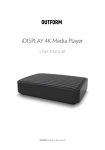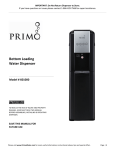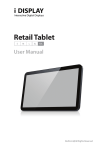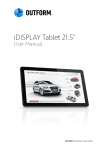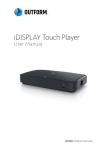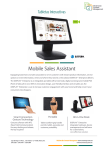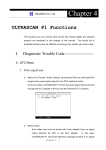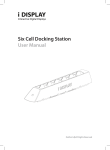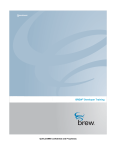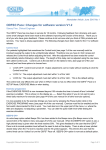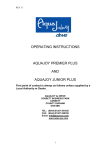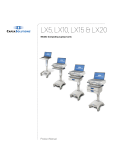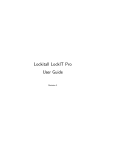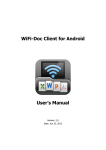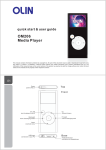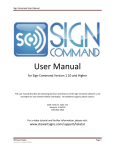Download - Outform
Transcript
iDISPLAY Enterprise User Manual Table of Contents About This Guide 2 Introducing iDISPLAY Enterprise 2 Important Notices 3 Copyright Information 3 Safety and Warning Information 4 Package Contents 5 Counter Stand Assembly Instructions 9 Locking the Rotating Base 11 Using the Anti-Theft Cable Lock 12 Backside Tablet Buttons 13 Using the NFC Cards 14 Playing Content and Using the Software 15 Playing Videos and Displaying Images 15 Supported File Formats 16 Unlocking the Counter Stand through the Software 16 Accessing the Pulse Player Settings 16 Pulse Player Settings 17 Using the Android Operating System 21 Configuring the Android Operating System Settings 22 Using Pulse Management 23 Troubleshooting 24 1 About This Guide Thank you for purchasing iDISPLAY Enterprise products. We recommend reading this user guide in its entirety in order to maximize the performance and service life of these products. These products are intended for commercial use and should be installed by authorized personnel only. Introducing iDISPLAY Enterprise iDISPLAY Enterprise is the newest addition to OUTFORM’s exclusive brand of iDISPLAY products. Including a new counter stand and tablet handle, iDISPLAY Enterprise delivers hands-free use as well as portability to sales associates in order to incite customer engagement at the point of sale. The tablet screen size is 10.1 inches, and includes an adaptive handle that makes carrying the tablet easy and secure. The tablet viewing angle adjusts to three different positions to accommodate glare from in-store lighting as well as user access. The counter stand utilizes a smart NFC card locking mechanism, ensuring the unit remains secure in commercial environments. As is standard on all iDISPLAY tablets, iDISPLAY Enterprise offers Pulse Technology, an exclusive OUTFORM technology that integrates hardware and software to create a comprehensive “out-ofthe-box” visual merchandising solution. 2 Important Notices Copyright Information Copyright © 2015 OUTFORM. All rights reserved. All intellectual property rights in this publication are owned by OUTFORM and protected by applicable copyright laws and international treaty provisions. OUTFORM retains all rights not expressly granted. No part of this publication may be reproduced in any form whatsoever or used to make any derivative work without prior written approval by OUTFORM. OUTFORM reserves the right to revise this publication, and/or make improvements or changes in the product(s) and/or the program(s) described in this documentation at any time without prior notice. The information in this document is provided in good faith, but without any representation or warranty whatsoever, whether it is accurate, or complete or otherwise, and on express understanding that OUTFORM shall have no liability whatsoever to other parties in any way arising from or relating to the information or its use. All other trademarks are the property of their respective owners. Other company and brand products and service names are trademarks or registered trademarks of their respective holders. This device complies with CE and FCC regulations. Operation is subject to the following two conditions: 1. This device may not cause harmful interference, and 2. This device must accept any interference received, including interference that may cause undesired operation. 3 Safety and Warning Information NOTE This mark is applied to indicate that the equipment conforms to European safety and electro-magnetic compatibility standards. WARNING! Main Supply: This equipment is designed to operate from a 100-240 Volt, 50/60Hz AC mains supply. The use of other power sources may damage this equipment. Check that the voltage marked on the rating plate located at the rear of the power adaptor states 100-240V. The manufacturer will NOT accept responsibility or damage or injury caused by connecting to the wrong voltage. WARNING! Main Adaptor: The supplied power adaptor is compatible with a standard main socket. If the power adaptor or lead gets damaged, it must be replaced by a qualified service agent with an approved adaptor of the same type and rating. WARNING! Dangerous voltage constituting a risk of electric shock is present inside this equipment. WARNINGS! The main plug shall be the main disconnect device and shall remain operable at all times. Do not push objects into holes and ventilation slots. Do not expose this product to dripping or splashing or place any objects filled with liquids on or near the product. Do not place a naked flame source, such as lighted candles, on or near this product. Do not attempt to repair this product yourself. Always use a qualified service agent to perform adjustments or repairs. 4 Package Contents Enterprise is shipped as two separate packages, including the tablet in one box and the counter stand in another box. The items listed on this page are included in the counter stand packaging: NFC Manager Card (Red Lock Icon) (x1) NFC User Card (Gray Lock Icon) (x3) Power Cable and Plug Adapters Usage: 5 Counter Stand Rotating Base Screw Counter Stand Front Side Back Side Card Reader Indication LED Back Side Port Cover Back Side Ports (Without Cover) 1 2 3 Description of Back Side Components: No. Description 1 USB Port 2 RJ45/Ethernet Port 3 Power Supply Cable Port 4 Anti-Theft Tag Insertion Slot 5 USB OTG Port, can be used for debugging purposes 6 4 5 iDISPLAY 10.1” Pro Tablet Front Side Camera Front Side 3.5 mm Audio Jack Right Side Back Side Camera Smart Connection Adapter Handle Back Button Back Side Power Button 7 Power Button LED Color States: Color Description Blue The tablet battery is fully charged. Red The tablet battery is being charged. Blinking or Temporarily Lit The tablet is being turned on or off, or standby mode is being activated or deactivated. No Color The tablet is either turned off or running on battery power, conserving energy. Smart Connection Handle The Smart Connection adapter can be used as a handle for holding the tablet. 8 Counter Stand Assembly Instructions The following steps describe preparing the counter stand for use, as well as connecting the tablet and Smart Connection adapter to the counter stand: 1. Mount the tablet and Smart Connection adapter onto the counter stand. Press down until the adapter clicks into place. NOTE: Once installed, the screen and Smart Connection adapter are locked to the stand and cannot be removed without the NFC card (described on page 14). 2. Unscrew and remove the rear bottom stand port cover. 9 3. Connect the power cable and optional RJ45/Ethernet cable to their respective ports on the back side of the stand. The counter stand and tablet automatically power on. 4. Reinstall the cover plate with the screws, and feed the power cable and optional RJ45/Ethernet cable through the two cover holes. 5. Adjust the angle and rotation of the screen. 180 30 10 Locking the Rotating Base The counter stand has two display positions. You may use it in a locked or rotary position. The factory default setting is in the rotary position. To immobilize the base, insert and tighten the provided screw using a Philips screwdriver into the hole at the center of the base. 11 Using the Anti-Theft Cable Lock An anti-theft scissor clip-type cable lock, purchased separately, can be used to secure the counter stand to a fixed object, as described below: 1. Separate the two pieces of the scissor clip as shown. 2. Insert the converged clip tips into the lock hole at the rear of the counter stand base, and then realign the clip pieces into one as shown. 3. Insert the cable attachment piece up into the scissor clip, loop the cable through the cable attachment piece, and then secure to a fixed object. 12 Backside Tablet Buttons Power Button If the tablet is powered off, press the power button on the back side of the tablet until it turns on. Conversely, to turn off the tablet, press the power button until an on-screen menu appears and select “Power off”. Standby Mode When the tablet is powered on, press the power button once to put the tablet in standby mode. The screen and some hardware components are temporarily powered off to save energy. Press the power button again to reactivate the tablet. Reset Function If the tablet is powered on and must be reset, continuously press the power button until the tablet restarts. All temporary software settings will revert to their default configurations. Back Button When the tablet is powered on, press this button to go back to the previously viewed content or exit out of the current view or app. 13 Using the NFC Cards A “user” NFC (Near Field Communication) card, identified by a gray colored lock icon, is programmed to unlock its assigned counter stand. A “manager” card, identified by a red lock icon, is used to configure which user card can unlock which stand. The counter stand must be turned on with the power supply cable plugged in for the NFC feature to work. To use an NFC User card: Touch the card up against the top rear rounded edge of the counter stand with an LED. The LED flashes blue for 10 seconds if the stand is paired with the card. During these 10 seconds, the Smart Connection adapter and tablet can be removed before the locking mechanism automatically relocks. Hold down the top curved edge of the counter stand with one hand and lift the tablet up and out by gently applying upward pressure on the bottom of the tablet using the other hand. To use an NFC Manager card: Touch the card up against the top rear rounded edge of the counter stand with an LED. The LED flashes red for 10 seconds with those counter stands assigned to the manager card set. To pair the NFC user card with the stand, the user card must touch up against the same area on the stand within these 10 seconds. The card’s previously configured setting is then replaced to only unlock the new stand. 14 Playing Content and Using the Software When the tablet powers on, the tablet automatically runs OUTFORM’s Pulse Player software by default, which runs on an Android operating system installed on the tablet. Pulse Player enables the tablet to play the desired content. Playing Videos and Displaying Images Copy video and image files to the tablet by using a USB thumb drive as follows: 1. Insert an empty USB drive into a computer and create a folder titled “0” (the number zero) at the topmost (root) directory of the drive. Ensure that no other content is on the drive. 2. Copy the desired video and image files to be played into the “0” folder. 3. Eject the drive from the computer and insert it into a USB port on the back side of the counter stand. 4. A password prompt appears on the tablet. Enter the configured password using the on-screen keyboard. By default this password is “11223344” without the quotation marks, and can be modified later. 5. Upon successful entry of the password, select one of the two options that display, either to delete and replace the existing content on the tablet or to simply add additional content. NOTE: If you choose to keep the existing content, the new content from the USB drive is copied alongside the existing content, and no files are deleted. However, if a file on the drive has the same name as a file already on the tablet, the file on the tablet will be overwritten. 6. After a message displays indicating that the content has been copied, the USB drive can be removed. The new content plays automatically. NOTE: When auto-copying files from a Linux or MAC OS-based computer, hidden metadata files, preceded by a period “.”, may also get copied into the “0” folder on the USB drive. When Pulse Player attempts to play or display these files, a black screen is shown momentarily. Use the Explorer app mentioned in the Android Operating System Settings section below to manually delete these metadata files from the “0” folder on the device. 15 Supported File Formats The tablet supports the following file formats: • Standard Android applications (APK files) supported by Android 4.0 and more recent versions • Video formats: 3gp / mp4 / avi / mkv / flv / mov / rm / rmvb • Image formats: jpg / jpeg / png / bmp Unlocking the Counter Stand through the Software When content is being played, draw an M shape on the screen. Touch and drag using your finger to create the shape, starting at the bottom left of the screen, in the direction shown to the right. Enter the configured or default password (“1234” without the quotation marks) when prompted to unlock the tablet and Smart Connection adapter from the counter stand. The stand locking mechanism will automatically relock after 10 seconds. Hold down the top curved edge of the counter stand with one hand and lift the tablet up and out by gently applying upward pressure on the bottom of the tablet using the other hand. Modify the “Counter Stand Unlock Password” Pulse Player software setting to configure the password for this function. Accessing the Pulse Player Settings When content is being played, draw a Z shape on the screen. Touch and drag using your finger to create the shape, starting at the top left of the screen, in the direction shown to the right. Enter the configured or default password (“11223344” without the quotation marks) when prompted to open the Pulse Player settings interface. Modify the “Change Password” Pulse Player software setting to configure the password for this function. 16 Pulse Player Settings The following table describes the Pulse Player settings. For more information on how to use the underlying Android operating system, refer to the following section. Setting Description Software Update Check for available Pulse Player software updates. This requires an Internet connection. Back Return to playing the configured content. Exit Exit Pulse Player and open the home screen of the base Android operating system. Exit Event Configure how the user stops content playback to open the Pulse Player settings interface. Settings include the following: • Z gesture: Draw a large Z shape on the screen by touching and dragging, starting at the top left of the screen. • Tapping the screen 5 times: Tap anywhere on the screen 5 times. • Z gesture and tapping the screen 5 times: Either draw a Z shape or tap 5 times as described above. Z Gesture Detection Accuracy Choose “Easy”, “Medium, or “Hard” to configure how accurately the user must draw the Z shape to perform the Exit Event. “Easy” indicates a low level of drawing accuracy, “Medium” a fair amount of accuracy, and “Hard” a stricter level of accuracy, all with regards to how straight the lines of the Z shape are drawn and whether the drawing is oriented correctly. 17 Setting Description Reboot Reboot the tablet. Status Bar Options Show and hide the Android operating system quick launch status and tool bar that appears at the bottom of the screen after exiting Pulse Player. “ON” shows the status bar, while “OFF” hides it. Volume Adjustment Options Enable and disable volume adjustment buttons on the exterior of the Pulse Player device. “ON” means the buttons are enabled, while “OFF” indicates that the buttons are disabled. Auto Start Pulse Player Enable and disable running Pulse Player automatically when the device powers on. “ON” indicates to automatically run Pulse Player, whereas “OFF” does not, instead configuring the device to load the Android operating system home page when the system powers on. MDM Function Enable and disable the Pulse Management software to remote control iDISPLAY devices. Pulse Management is explained in-depth on page 23 of this user guide. Change Password Select this setting to modify the configured password used to perform administrative tasks related to Pulse Player. Default Password Visibility Options Show (“ON”) or hide (“OFF”) the configured default password in the password entry field. Password Validation Feature Options Enable (“ON”) or disable (“OFF”) option to password restrict administrative tasks related to Pulse Player. Image Interval Time Adjust the length of time (in seconds) an image or picture is displayed before displaying the next image or video. The configured time value can be within the range of 2 – 200 seconds. Video Ratio Options “ON” indicates keeping the original video and image size ratio when being played or displayed, whereas “OFF” indicates resizing content to fit the screen. Player Orientation Options “ON” enables automatic screen orientation recognition based on how the device is positioned, enabling the portrait display orientation. “OFF” keeps the screen oriented in the default landscape display orientation. 18 Setting Description Log Options “ON” enables recording Pulse Player log messages to a log file stored in the internal device memory. If this setting is enabled, the log file “PulsePlayer_Log.txt” is created and stored in the top-most directory of the device’s internal memory, which can be accessed through the “Explorer” Android operating system app. Counter Stand Unlock Password Select this setting to modify the configured password that unlocks the tablet and Smart Connection adapter from the counter stand. Counter Stand Unlock M Gesture Enable (“ON”) and disable (“OFF”) the ability to unlock the tablet from the counter stand through the software. Set the password for this feature by modifying the “Counter Stand Unlock Password” setting. Forward To Options Enable (“ON”) and disable (“OFF”) a “forward event” initiation, such as opening a configured webpage (caused by the user touching the screen when content is playing). When enabled, specific settings related to the event display immediately below this setting. Forward Target(TP Folder/URL) Shown when the “Forward To Options” setting is enabled. Options include either specifying a URL to which the user is forwarded, opening the Pulse Player web browser, which also enables the “Set URL” setting (see this setting’s description below), or “TP Folder”, which causes an event configured by content, such as a web page file, stored in the “tp” folder to be opened or played. TP folder content must be loaded into the device’s top-level internal memory directory for the “TP Folder” forward target setting to work. Default Browser Shown when the “Forward To Options” setting is enabled. Specifies the web browser to use to manage a URL forward event. By default only the “Pulse browser” is an available option, but for some customers specially configured browsers can also be selected here. Set URL Shown when the “Forward To Options” setting is enabled and configurable when the “Forward Target(TP Folder/URL)” setting is set to “URL”. Select this setting to specify a forward event URL. Do not include “http://” at the beginning of the URL. 19 Setting Description Inactivity Time-out The length of time (in seconds) it takes for a password input field or forward event webpage to time-out. The value specified must be at least 15 seconds. In the case of a password input field, once the inactivity time is reached, the field disappears and the content continues playing. In the case of a URL forward event, this amount of time specifies when a warning dialog pops up prompting the user to stay on the page or return to the initially playing content. Warning Dialog Expire Time The length of time (in seconds) from which the forward event webpage inactivity time-out warning dialog appears until Pulse Player returns to playing the initially configured video or image content. The value specified must be at least 10 seconds. Hardware Acceleration Options Enable (“ON”) or disable (“OFF”) hardware acceleration for better video playback performance, if needed. Progress Box Options Display (“ON”) or hide (“OFF”) an animated loading progress icon when loading a forward event URL. Reboot Scheduler Configure a daily reboot time to ensure Pulse Player and the underlying Android operating system memory is regularly cleared and refreshed so as to maintain good playback performance for extended periods of time. OUTFORM recommends scheduling a daily reboot time when no customers are expected to use the device. Reboot On Error Turn this setting on to automatically reboot the device if Pulse Player detects an error. 20 Using the Android Operating System This section describes parts of the underlying Android operating system that are relevant to using Pulse Player on OUTFORM devices. More important interface elements are described below: Applications Menu On the bottom or side of the Android home screen, which by default has a light blue background with scattered lighter colored squares, the applications menu can be accessed by tapping on the white circular icon with six white smaller squares. The applications menu contains commonly used Android applications and tools. The following three applications most relevant to using your iDISPLAY device are described below: PulsePlayer Opens and runs the Pulse Player software to play interactive content. Explorer A file and folder system management application. Use Explorer to manually manage files to be played by Pulse Player (located in the “0” and “TP” folders, if present), as well as to access other system-specific files such as the Pulse Player log file. Settings Configure the Android operating system settings, such as to turn on and connect to a wireless network. The following section describes these settings more in-depth. 21 Configuring the Android Operating System Settings Tap on the “Settings” icon to configure the following three relevant Android system settings: Connecting to a Wireless Network The preselected item on the left hand settings menu is “Wi-Fi”. To enable wireless connections, drag the “Wi-Fi” menu item slider to the right to display “ON”. After a few seconds available wireless networks appear on the right side of the screen. Select a network to configure and connect to it. Connecting to a Wired Network Select “More…” on the Android settings left hand menu. On the menu to the right, select “Ethernet” and ensure “Use Ethernet” is checked. Immediately below the “Use Ethernet” option, open “Static IP Settings” to configure your network’s wired connection settings. Enable USB Debugging This setting allows developers to debug their applications. Select “Developer options” on the left hand menu and then ensure “USB debugging” on the right is checked. 22 Using Pulse Management Pulse Management is an additional subscription-based feature that can be used to remotely control iDISPLAY devices. When connecting to the Internet, the Pulse Management app automatically connects to the service’s servers, as is indicated by the “Registering Device” message that briefly appears. If connecting to the Internet for the first time, a prompt appears requesting device administrator activation. As Pulse Management is intended to run in the background regardless of whether your organization has registered for a Pulse Management account, select “Activate”. Note that the Pulse Management app icon is present in the Android app menu, but serves no function other than to indicate that the app has been installed. Tapping on the app icon simply runs the software in the background without displaying any visual messages or confirmations. The service can be enabled and disabled by adjusting the “MDM Function” setting in the Pulse Player settings menu. Contact OUTFORM for help in setting up the Pulse Management service. 23 Troubleshooting The following section lists common questions and troubleshooting scenarios. When the Pulse Player forward to URL option is enabled, why does the configured website not appear when I touch the screen? Two possible reasons are explained below: • The device is not connected to the Internet. Refer to “Configuring the Android Operating System Settings” above. • Ensure the configured URL is correct in the Pulse Player settings. Also, do not include “http://” at the beginning of the URL. When I insert a USB drive into my iDISPLAY device, the system does not automatically prompt me to load my content onto the device. Check the following: • Ensure Pulse Player is running. • Unplug and reinsert the USB drive to ensure the drive is connected properly. • Ensure content to be played on the device is stored in a folder named “0” (the number zero), and that this folder is located at the top-most (root) directory of the USB drive. • Use your computer to check if the USB drive contains an error. View your computer’s operating system documentation to troubleshoot any problems related to the USB drive. • The USB drive was inserted into the “USB OTG (On-The-Go)” port of the iDISPLAY device with the Android system “Developer options” setting “USB Debugging” enabled. The “USB OTG” port can also be used for developer debugging purposes. If the “USB Debugging” setting is enabled, only the “USB” port (left side port) can be used to load content onto the device. To use the “USB OTG” port, disable “USB Debugging”. What is the default Pulse Player password? The default password is “11223344” without the quotation marks. What is the default counter stand unlock password? The default password is “1234” without quotation marks. Why does my device reboot multiple times when I auto-copy data from my USB drive? This happens when an unsupported/corrupt file is copied to the device. Pulse Player has a built-in auto recovery program that reboots the device a minimum of 5 times to protect the software configuration. After rebooting a number of times, a prompt appears requesting to delete the currently loaded content. Select “Yes” and enter your password. The content stored in the “0” folder on the device is deleted. Doublecheck the files on your computer to fix any problems related to the files, recopy the 24 desired content to the USB drive from your computer, and then perform the auto-copy procedure a second time. I do not have an NFC card on me. How do I unlock the tablet from the counter stand? See “Unlocking the Counter Stand through the Software” on page 16 above. I drew an M shape on the screen and entered the password, but still cannot remove the tablet? After 10 seconds the counter stand locking mechanism automatically relocks. Remove the tablet immediately after drawing the M shape and entering the relevant password. Why does nothing happen when I swipe an NFC card on the counter stand? Make sure the card physically makes contact with and touches up against the top rear rounded edge of the counter stand with an LED. Hold the card in this position until the LED reacts by blinking. Why does the counter stand not unlock when I swipe the manager NFC card? The manager card is only used to pair user cards with counter stands, and does not unlock counter stands. I lost an NFC card. What do I do? The box that the counter stand arrives in when delivered contains 1 manager NFC card and 3 user NFC cards. If you lost one of the user cards, ask the responsible person in your organization for one of the backup user cards. If none of the user cards can be located, or the manager card has been lost, contact OUTFORM to order more cards: http://outform.com/support/ How do I adjust the sound, screen brightness, Android system language preferences, etc.? All of these Android system-specific settings can be adjusted in the Android Settings interface, accessible via the Android operating system home screen. How can I contact OUTFORM about any other issue not listed here? Please contact us through our support webpage: http://outform.com/support/ 25 For further information or support, please contact us at http://outform.com/support/



























